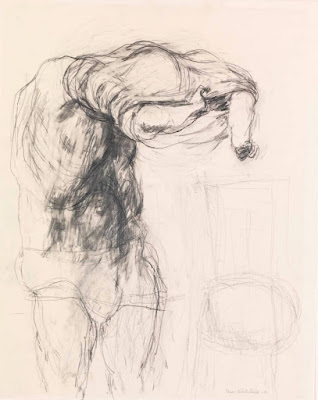-2017-pigment-print-KORO-(Public-Art-Norway)-Oslo.jpg) |
| Espen Gleditsch Faded Remains (Narcissus) 2017 pigment print KORO (Public Art Norway), Oslo |
 |
| Eugène Carrière Figure Study ca. 1890 oil on canvas Von der Heydt Museum, Wuppertal |
 |
| Claes Bäckström Undressing 1962 drawing Moderna Museet, Stockholm |
 |
| Marco Aggrate Mary Magdalen ca. 1700 marble Chrysler Museum of Art, Norfolk, Virginia |
 |
| Otto Dix Portrait of Karl Krall 1923 oil on canvas Von der Heydt Museum, Wuppertal |
 |
| Christoffer Wilhelm Eckersberg Study of the model Florentine 1841 oil on canvas Hirschsprung Collection, Copenhagen |
 |
| Jean-François Millet Seated Model ca. 1847-48 oil on panel Museum of Fine Arts, Boston |
-c1982-gelatin-silver-print-Moderna-Museet-Stockholm.jpeg) |
| Anders Petersen Rome (series, City Diary) ca. 1982 gelatin silver print Moderna Museet, Stockholm |
 |
| Francis Bacon Double Portrait of Lucian Freud and Frank Auerbach 1964 oil on canvas Moderna Museet, Stockholm |
 |
| Giulio Bonasone Danaë and the Shower of Gold ca. 1545 engraving Museum of Fine Arts, Budapest |
 |
| Moise Benkow Sorrow 1933 gelatin silver print Moderna Museet, Stockholm |
-Borghese-as-Venus-1804-1808-marble-Galleria-Borghese-Rome.jpg) |
| Antonio Canova Pauline (Bonaparte) Borghese as Venus 1804-1808 marble Galleria Borghese, Rome |
 |
| Edgar Degas Le Lever ca. 1880-85 monotype Nasjonalmuseet, Oslo |
 |
| Charles Paul Landon Venus and Cupid 1810 oil on canvas Musée des Beaux-Arts de Nice |
 |
| Håkon Bleken Christian 1977 oil on canvas Nasjonalmuseet, Oslo |
 |
| Agostino Carracci Venus and Cupid ca. 1599 drawing Museum of Fine Arts, Budapest |
And then I took my first taste of the Nile, unadulterated by wine, to see how sweet that water was; for water wanes when wine intervenes. I scooped some up in a clear glass goblet and watched the water and its vessel compete for clarity: the glass lost. The water was sweet and cold, though not unpleasantly cold – I know some comparable streams in Greece whose cold can cut your tongue. Accordingly the people of Egypt are not afraid to drink this water neat, disdaining Dionysos. And I was struck, too, by their drinking style: they scorn all use of bucket or cup, when nature has fashioned a drinking instrument right at hand – the hand. If anyone is cruising down the stream, and feels a little thirsty, he pokes his head over the side, leans towards the water, lowers hand, forms cup, aims a fistful mouth-wards, and launches it on target – the gaping mouth awaits the shot, receives it, closes, and doesn't spill a drop.
– Achilles Tatius, from Leucippe and Clitophon (2nd century AD), translated from Greek by John J. Winkler (1989)